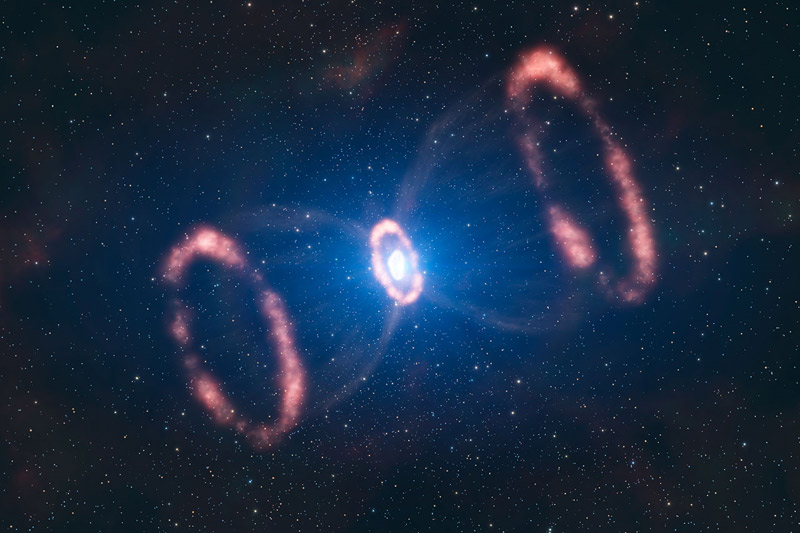Stellar Explosion Seen in 3-D

Astronomers have generated a 3-D view at a famedexploding star to reveal how fast the powerful supernova ejected material whenit died.
The stunning view comes from new observations of thewell-known Supernova 1987A, which as its name suggests exploded in 1987 and wasthe first naked-eye star explosion seen in 383 years. [Illustration of the 3-Dsupernova.]
The original blast was not only powerful, it was alsomore concentrated in one particular direction, according to the new study. Thisis a strong indication that the supernova must have been very turbulent,supporting the most recent computer models, researchers said.
"We have established the velocity distribution ofthe inner ejecta of Supernova1987A," said the study's lead author Karina Kjaer,an astronomer with the European Southern Observatory. "Just how a supernovaexplodes is not very well understood, but the way the starexploded is imprinted on this inner material. We can see that this material wasnot ejected symmetrically in all directions, but rather seems to have had apreferred direction. Besides, this direction is different to what was expectedfrom the position of the ring."
The researchers found that the first material ejected from the supernova travelled at a whopping 62million mph (100 million kph). That is nearly one-tenth of the speed oflight or around 100,000 times faster than a passenger jet, researchers said. Evenat this breakneck speed, the material took 10 years to reach a previouslyexisting ring of gas and dust puffed out from the dying star, they added.
The new observations also showed that anotherwave of material is travelling 10 times more slowly and is being heated byradioactive elements created in the explosion.
Such asymmetric behaviorwas predicted by some of the most recent computer models of supernovae, whichfound that large-scale instabilities take place during the explosion. The newobservations provide the first direct confirmation of such models.
Get the Space.com Newsletter
Breaking space news, the latest updates on rocket launches, skywatching events and more!
Supernovas are the spectacular finale for massive starsthat, once arriving at the end of their life, detonate to expel vast quantitiesof material. Such stars are larger than our sun, which will end its days in amore subdued manner.
Supernova 1987A, however, is one such star explosion andis located in the nearby Large Magellanic Cloud, a satellite galaxy of our ownMilky Way. Because of its relative closeness, the supernova has made itpossible for astronomers to study the explosionof a massive star and its aftermath in more detail than everbefore.
Kjaer and her colleagues used ESO's Very Large Telescope in Chile to measure thespeed at which Supernova 1987A flung material outward.
The research will be detailed in the journal Astronomyand Astrophysics.
- Gallery: Great Photos from the Very Large Telescope
- World's Largest Telescope to Be Built in Chile
- Supernova Explosion Recreated in 3-D
Join our Space Forums to keep talking space on the latest missions, night sky and more! And if you have a news tip, correction or comment, let us know at: community@space.com.

Space.com is the premier source of space exploration, innovation and astronomy news, chronicling (and celebrating) humanity's ongoing expansion across the final frontier. Originally founded in 1999, Space.com is, and always has been, the passion of writers and editors who are space fans and also trained journalists. Our current news team consists of Editor-in-Chief Tariq Malik; Editor Hanneke Weitering, Senior Space Writer Mike Wall; Senior Writer Meghan Bartels; Senior Writer Chelsea Gohd, Senior Writer Tereza Pultarova and Staff Writer Alexander Cox, focusing on e-commerce. Senior Producer Steve Spaleta oversees our space videos, with Diana Whitcroft as our Social Media Editor.









